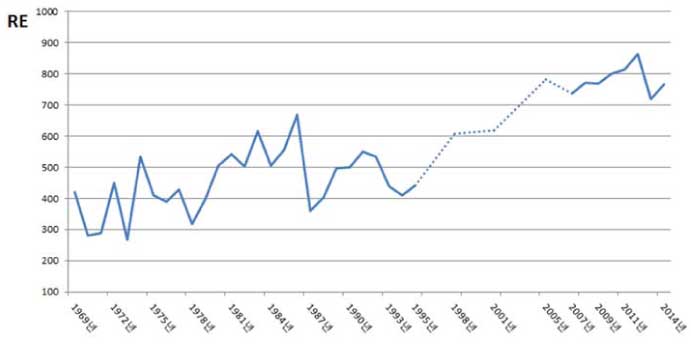References
1. Kim HY. Vitamin A. In : Ziegler EE, Filer LJ Jr, eds. Present knowledge in nutrition 7th edth ed. Seoul: The Korea Nutrition Society, International Life Sciences Institute of Korea; 1998. p. 111–121.
4. Koo J, Lim HS, Jeong YJ, Yoon JS, Lee AR, Lee JH. Understanding basic nutrition 1st edth ed. Seoul: Powerbook; 2008. p. 243–250.
5. Ministry of Health and Welfare, Korea Centers for Disease Control & Prevention. Korea Health Statistics 2013: Korea National Health and Nutrition Examination Survey [KNHANES VI-1] [internet] 2014. cited 2016 Jun 14. Available from:
https://knhanes.cdc.go.kr/knhanes/index.do.
6. Ministry of Health and Welfare. 95 National nutrition survey report Seoul: Ministry of Health and Welfare; 1997. p. 50–53.
7. The Korean Nutrition Society. Dietary reference intakes for Koreans Seoul: The Korean Nutrition Society; 2005. p. 83–92.
8. Ministry of Health & Welfare, The Korean Nutrition Society, Ministry of Food & Drug Safety. Dietary reference intakes for Koreans 1st revisionth ed. Seoul: Ministry of Health & Welfare, The Korean Nutrition Society, Korea Food & Drug Administration; 2010. p. vi–x x iii.
p. 149–165.
9. Ministry of Health & Welfare, The Korean Nutrition Society. Dietary reference intakes for Koreans 2015 Seoul: Ministry of Health & Welfare, The Korean Nutrition Society; 2015. p. 2–23.
p. 240–276.
10. Korea FAO Association. Recommended dietary allowances for Koreans Seoul: The FAO Korea Association; 1962. p. 13. p. 45.
11. Korea FAO Association. Recommended dietary allowances for Koreans 3rd revisionth ed. Seoul: The FAO Korea Association; 1980. p. 5p. 19–20.
12. Korea Institute for Population and Health. Recommended dietary allowances for Koreans 4th revisionth ed. Seoul: Korea Institute for Population and Health; 1985. p. 9p. 27–29.
13. Korea Institute for Health and Social Affairs. Recommended dietary allowances for Koreans 5th revisionth ed. Seoul: Korea Institute for Health and Social Affairs; 1989. p. 11p. 33–35.
14. The Korean Nutrition Society. Recommended dietary allowances for Koreans 6th revisionth ed. Seoul: The Korean Nutrition Society; 1995. p. 14p. 127–134.
15. The Korean Nutrition Society. Recommended dietary allowances for Koreans 7th revisionth ed. Seoul: The Korean Nutrition Society; 2000. p. 83–90.
p. 490.
16. Korea FAO Association. Recommended dietary allowances for Koreans 1st revisionth ed. Seoul: The FAO Korea Association; 1967. p. 53–54.
17. Korea FAO Association. Recommended dietary allowances for Koreans 2nd revisionth ed. Seoul: The FAO Korea Association; 1975. p. 57–58.
18. Ministry of Health and Welfare, Korea Centers for Disease Control & Prevention. Korea Health Statistics 2014: Korea National Health and Nutrition Examination Survey [KNHANES VI-2] [internet] 2015. cited 2016 Jun 14. Available from:
https://knhanes.cdc.go.kr/knhanes/index.do.
19. Gibson RS. Principles of nutritional assessment New York Oxford: Oxford University Press; 1990. p. 69–70.
p. 92–93.
p. 101–109.
p. 148–152.
20. Lee SY, Jeong HJ, Lee YE, Kim MR, Kim KR, Song HN. Food chemistry Seoul: Powerbook; 2009. p. 179–182.
p. 260–267.
21. Ministry of Health and Welfare, Korea Centers for Disease Control & Prevention. Korea Health Statistics 2009: Korea National Health and Nutrition Examination Survey (KNHANES Ⅳ-3) [internet] 2010. cited 2016 Jun 14. Available from:
https://knhanes.cdc.go.kr/knhanes/index.do.
22. Ministry of Health and Welfare, Korea Centers for Disease Control & Prevention. Korea Health Statistics 2008: Korea National Health and Nutrition Examination Survey (KNHANES IV-2) [internet] 2009. cited 2016 Jun 14. Available from:
https://knhanes.cdc.go.kr/knhanes/index.do.
23. Kim Y. A study on calculation methods and amounts changes of recommended protein intake in the recommended dietary allowances for Koreans and dietary reference intakes for Koreans. J Korean Home Econ Educ Assoc 2012;24(2):51–62.
24. Yeum KJ, Lee-Kim YC, Lee KY, Kim BS, Roh JK, Park KS. The serum levels of retinoids, β-carotene and α-tocopherol of cancer patients. J Korean Cancer Assoc 1992;24(3):343–351.









